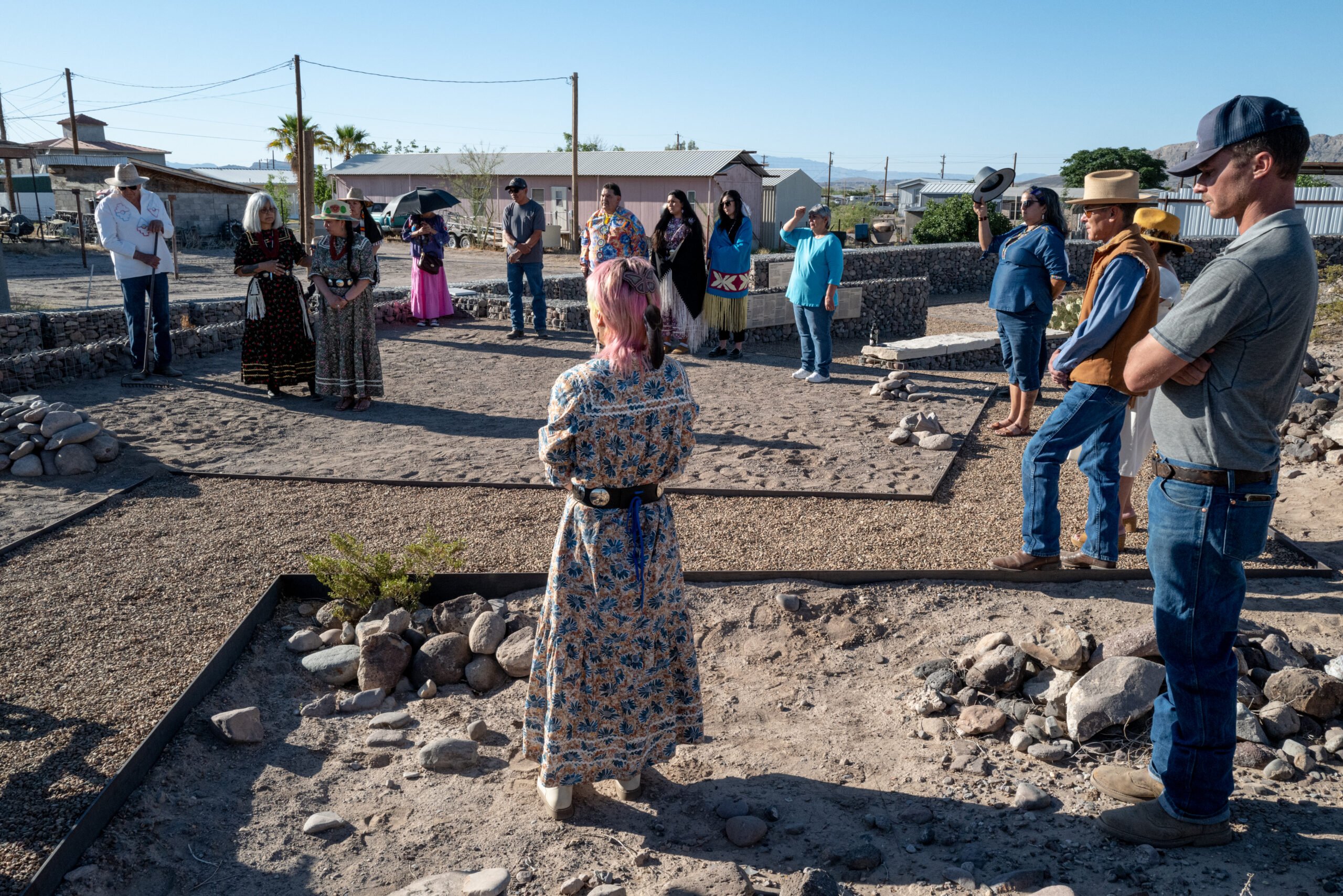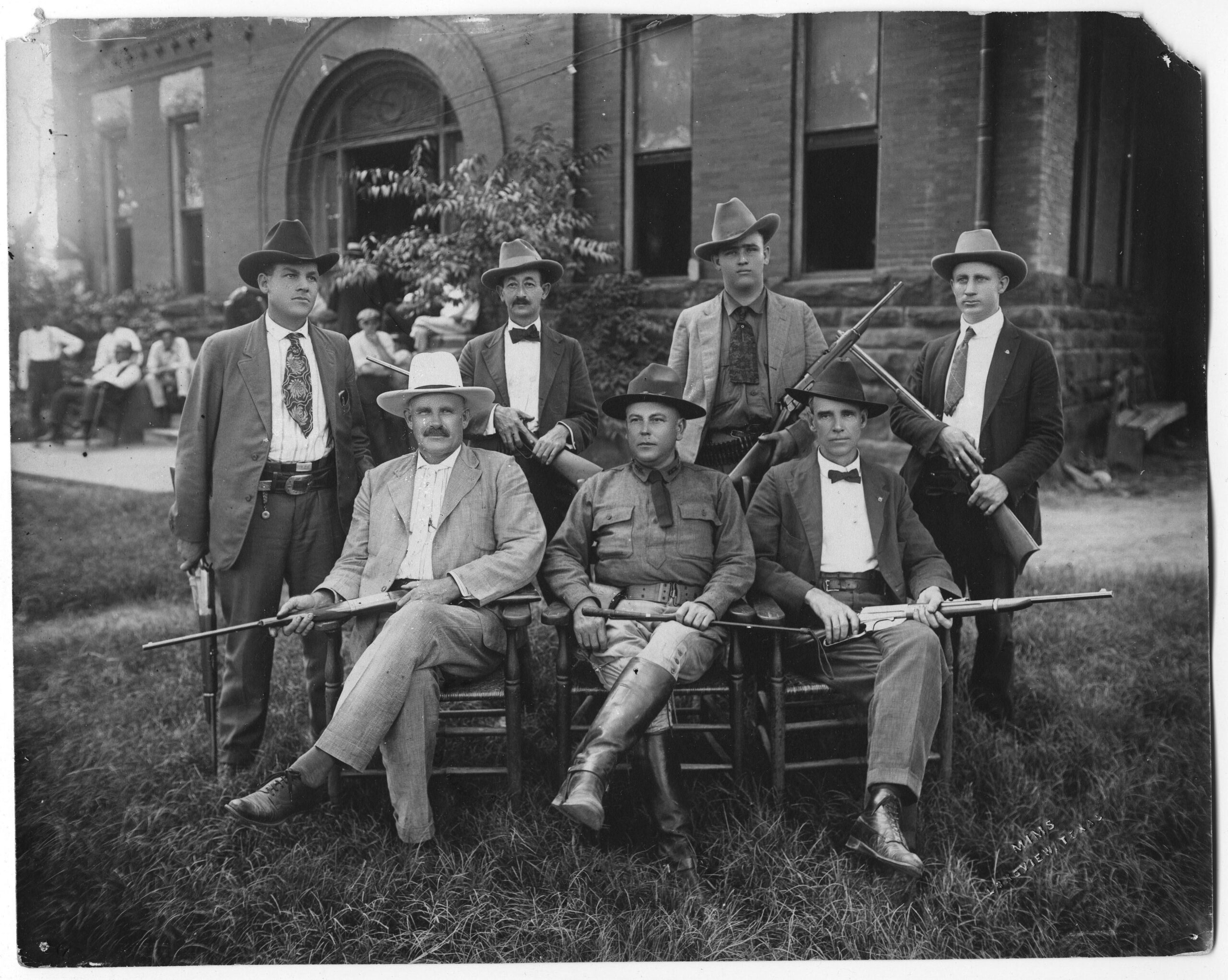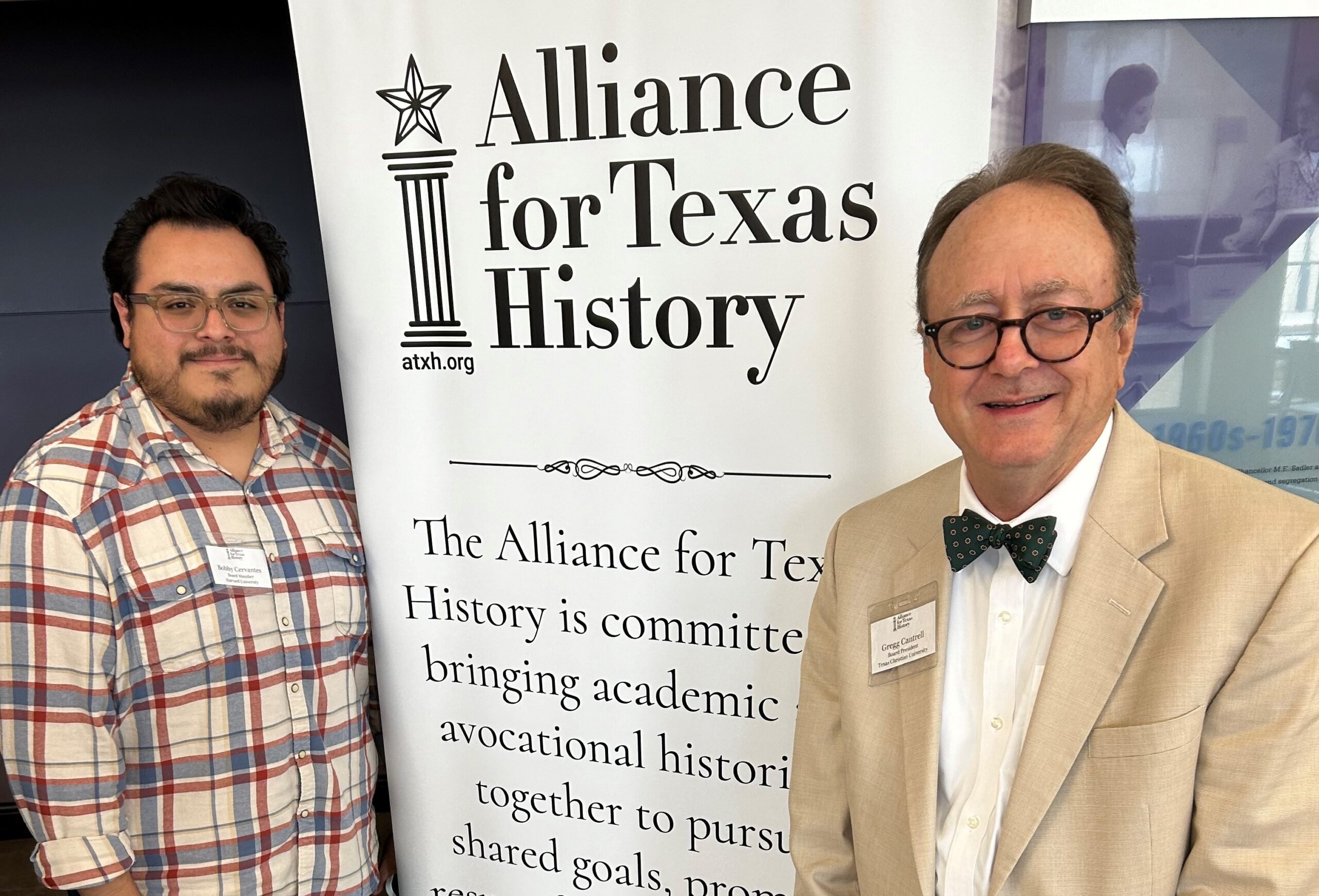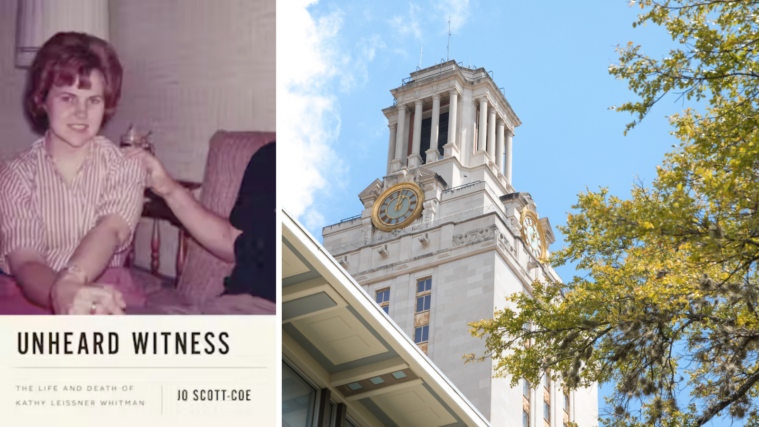About 750 years ago, an Elder died. I don’t know what killed her. In fact, I know very little about her life. But she must have been loved. Because she was laid to rest in a sacred place: an arroyo at the foot of the Chinati Mountains of Far West Texas.
The Elder’s family probably believed that she’d be safe within the land. And for a very long time, she was.
Then, in 2020, I received a call from my mother, who shared a curious story. Xoxi Nayapiltzin, a supporter and member of the Indigenous community in South Texas, had recently visited Chaa Ranch as a guest of the owner, Pilar Pedersen. Well, that day, upon entering an arroyo, Xoxi noticed a broken metate (a stone bowl used for grinding corn) on the ground. Indigenous women were—are—often laid to rest with their metate.
Xoxi told Pilar, his dear friend, that there might be a burial site nearby. Yes, Pilar confirmed. In the 1980s, others had seen partially exposed bones in the arroyo. Centuries of erosion had unearthed the Elder. Unsure where the remains came from or whether there’d been foul play, they had contacted authorities for help. Subsequently, the Center for Big Bend Studies of Sul Ross State University took those bones for study. The university still had them.
Under a federal law called the Native American Graves Protection and Repatriation Act (NAGPRA), Native bodies and burial artifacts held by public universities and other institutions are supposed to be returned to their rightful tribal nation. But that law only applies to federally recognized tribes.
Unfortunately, the Lipan Apache and most other Indigenous peoples who lived and still live around the Chinati Mountains have never been recognized by the federal government. Thus, even if the Elder’s remains were covered by NAGPRA, her closest living relatives likely could not use the law to request a reburial. She was effectively trapped within an academic mausoleum.
I didn’t know it when I first heard this story, but my family would be critical in bringing the Elder home.

Darcie Tawóctcete Altsese shezhii (My name is Darcie Little Badger). On my father’s side of the family, I descended from Irish-American immigrants who came to the United States in the 20th century. And on my mother’s side, I’m Lipan Apache, of the Little Breech Clout Band (or, as great-grandma called us, “Apaches de Poca Ropa”). My maternal line arrived on this continent before the wooly mammoths went extinct. Over the centuries, my ancestors traveled south, eventually settling in the region now known as the U.S.-Mexico borderlands. To us, home is kíłááhíí, the land of many houses. My great-great-grandma was born in Texas, my great-grandma was born in Texas, my grandma was born in Texas, my mom was born in Texas, and I, well, I was born in Minnesota.
Growing up, I moved a lot—Minnesota, Malaysia, Iowa, Vermont—as my parents saved their teacher salaries, dreaming of a more secure future. We’d return to the homeland someday, they promised. My mothers’ people, the Lipan Apache, are from Texas and northern Mexico, and our tribe is recognized by the State of Texas through concurrent and other jointly issued resolutions, as well as in the federal court of claims.
Finally, my parents bought a house in Texarkana. Fragrant pink rose bushes lined the driveway, and the kitchen was shaped like a castle tower. At least, that’s what I imagined as a fanciful high school student. A few years later, Mom lost her job due to disability, and a medical bill pushed my parents into unmanageable debt. They lost the house.
It wouldn’t be the first time my family was displaced. In fact, my people have been displaced for generations.
“We are resilient as these stones.”
In 1838, the “treaty of Peace and perpetual friendship between the Republic of Texas and the Lipan tribe of Indians” supposedly cemented the amicable relationship between my people and Texas. Sam Houston once wrote, “We will be kind to the Lipans. Grass will not grow on the path between us.” My ancestors traded with the settlers, guarded their new little cities, exchanged stories, and made human connections. We willingly shared our homeland with them. But, when Texas became a state in 1845, the federal government decided to take everything. Officials considered putting the Lipan on a reservation outside of Texas. However, these plans fell through because we refused to be relocated and, as a nomadic group, we were difficult to capture. We’d never stop resisting.
That’s why the federal government decided to exterminate the Lipan. In this country, there’d be no Bureau of Indian Affairs support for my people, no tribal land. For many decades, there’d be no safety, either.
When my great-great-grandmother Lorenza was born in the 1870s, the United States and Mexico launched joint military campaigns against the Lipan. At the same time, through a law passed in 1874, the 44th U.S. Congress made it illegal for Indians—“filthy barbarians,” according to its statement—to exist freely within Texas. The congressional document declared, “[Indians] should be kept in the reserves, and not allowed to leave under any pretext.” In other words, the United States’ war of extermination involved destruction through military violence and legal decree.
But their law was not ours: The Lipan remained in Texas, where the bones of our ancestors, like the Elder, had been buried centuries ago, when our tribe was just beginning to differentiate itself culturally and linguistically from other Apaches.
In spite of our survival, the federal government does not officially acknowledge the Lipan Apache Tribe. Of course, institutions such as the Department of Homeland Security and the Department of the Interior’s Fish and Wildlife Service will sometimes correspond with my tribal nation, but our sovereignty is ignored by the Bureau of Indian Affairs, and we are not served by laws or programs that apply to federally recognized Indigenous nations. This is why NAGPRA neglects the Lipan Apache. We cannot use federal law to reclaim our historic artifacts or the bones of our elders.
In addition, until recently, we had no tribal land. Even after we were made “unlawful,” my people lived in clusters throughout Texas in our Indigenous communities known as rancherías. And while rancherías allowed us to survive, we were often one disaster or unpaid bill away from displacement. We just had to struggle. We still do. In the eyes of the government, we are breathing ghosts.
I grew up hearing tragic stories about Hurricane Beulah, which hit southern Texas in 1967. “Torrential rains, which triggered the floods, totaled near 30 inches in some areas. … Streams that normally flow at little more than a trickle were turned into rampaging rivers,” the National Weather Service reported.
Mom often relives the moment those waters destroyed her first home. In the middle of the night, as my grandma Anita, grandpa Alfonso, and their nine children slept in McAllen, there came a frantic knock on the door and a shout to evacuate. The flood was coming. Behind the house, my grandparents’ cows mooed in confusion and distress. With no time to move them to safety, grandpa opened the gate, then the family of eleven fled.
The flood engulfed my grandparents’ neighborhood. Their house, furniture, clothes, toys, documents, everything was destroyed. To this day, mom, the eldest daughter, still talks about the family photos that were lost and the history we’ll never see again. After the water receded, grandpa returned to the ruins and witnessed one small miracle: The cows had found refuge on a hill. All survived.
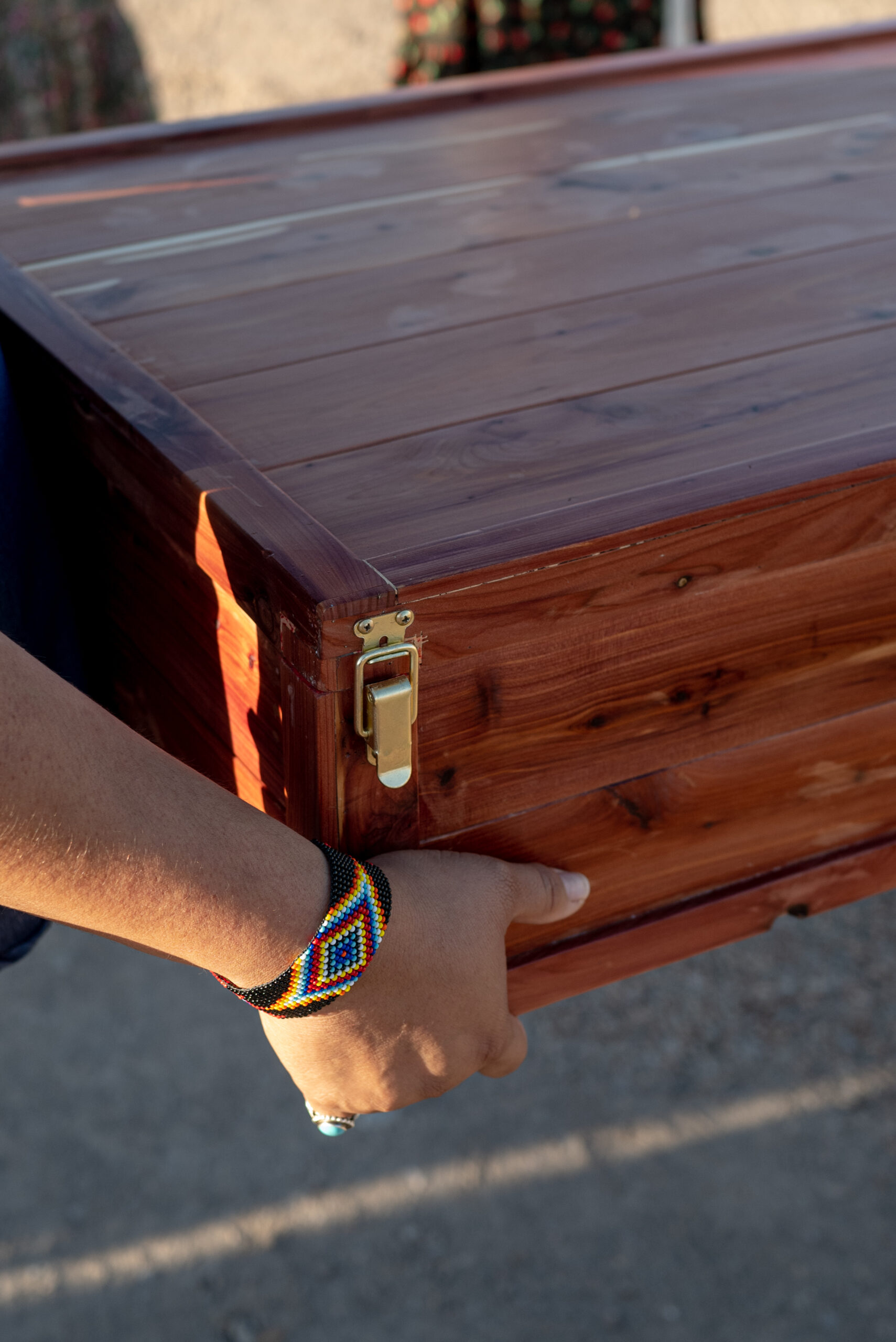
Unfortunately, tragedies cluster. One-and-a-half years later, while the family was trying to rebuild, my grandfather died in a car accident. Their house was unfinished, and grandma Anita had no salaried job, just grandpa’s social security and veteran’s benefits. To make ends meet, she sold tamales. Yet she kept the land for both her family and community—the Lipan of McAllen. For special events—birthdays, holidays, pow wows, and other ceremonial gatherings—grandma Anita cooked tamales and tortillas by the hundreds. She ground corn into flour using her metate, her hands callused by hard work.
No matter where I lived with mom and dad, no matter how uncertain the future seemed, I felt at home on grandma’s land. It’d been in the family for fifty years, which seemed like forever to me. Then, one day, my mother called. She grimly explained that grandma had fallen, and her condition was deteriorating. I couldn’t believe it. In my heart, grandma was as eternal as the land. My mother and I quickly flew to McAllen. For the next month, we stayed at grandma’s bedside, praying that her condition would improve. It did not.
The night grandma Anita died, I climbed the citrus tree behind her house and crawled onto the roof. Red ants bit my legs and arms, but I brushed them aside, unconcerned with that pain. I looked up and tried to see the stars, but the sky went dark.
Grandma Anita’s eight living children and two of her grandchildren inherited her property. Unfortunately, nobody could afford the hiked-up taxes. Only a sliver of land remains within the family; it’s where one of my cousins lives.
I guess I lost hope when grandma died. I thought there’d never be security for the Lipan. We’d never be safe. We—I—would always be one tragedy or disaster away from displacement yet again. As the years passed, I heard stories that cemented my despair.
For example, there’s a traditional Lipan burial ground in Presidio called el Cementerio del Barrio de los Lipanes. The majority of graves are adorned with simple cairns of local rocks or are unmarked, in accordance with our traditions. Although it was declared a State Antiquities Landmark in 2014, many stones had been moved and taken, and people used the burial ground as a garbage dump. Our sacred land had fallen into disarray, and we were powerless to protect it.
Even Indigenous bodies weren’t safe. That’s when mom told me about the Elder’s remains, how her bones were somewhere in storage. Reality wore me down, made me a pessimist. But, fortunately, others didn’t give up. In 2021, my mother called and said, “You know el cementerio? … Presidio County is transferring it back to our tribe.”
This good news came as a shock. It would mark the first time that any government in Texas ever returned land to the Lipan. Determined advocates—including descendents of those buried in el Cementerio (notably Christina Hernandez and Oscar Rodriguez) and our chairman Bernard Barcena and vice-chairman Robert Soto—had fought for the burial ground.
In May, my mother, my brother, and I drove to Presidio to attend the burial ground’s blessing ceremony. It was nightfall when we reached the city. Up ahead, the lights of Ojinaga were as bright as a bioluminescent sea. But Presidio itself was such a small place, I couldn’t see much until sunrise, when my family went to the burial ground.
A small group of people were already waiting, ranging in age from children to elders. Some wore traditional regalia. Others, like my brother, wore casual clothes. We were all there for one reason: to protect our sacred land. A drum circle played, the burial ground was blessed in our traditional way, and then I was asked to speak. As I stood before my community, I noticed a stack of rocks at the edge of el cementerio. Residents of Presidio had returned the sacred stones, it seemed, wanting to make things right. “We are resilient as these stones,” I said. Then the work began.
We picked up the litter, the cans, the wrappers, then returned the stones to the graves. Kids carried pebbles. My brother, who worked at a Target warehouse, carried a boulder. By the end of the day, the burial ground was clean, respected. There was still work to do, but I was confident that it would get done. The sacred land would be protected. That’s when hope sparked within me. Maybe the Lipan would be alright someday.
Yet I knew there was still a long way to go. We might have land for our ancestors, but what about the living? And how could we help our ancestors who’d been unearthed and taken away? Some volunteers in our tribe are working on federal recognition, but that will be a long and complicated process. Once again, I felt powerless. But my mother had hope. Shortly after the blessing ceremony, my mother called again. She asked, “You know those 700-year-old remains from Presidio? … She’s our distant relative.”
Surprised, I asked her to repeat herself.
During the course of their archeological study, researchers had tested the Elder’s mitochondrial DNA. MtDNA, which is passed down the maternal line and has a relatively low rate of change, can demonstrate descent from an ancient person. So my great-great-grandma gave her mitochondrial DNA to my great-grandma, who gave it to my grandma, who gave it to my mother, who gave it to me.
After Xoxi learned of the Elder’s remains, he contacted our tribe because he knew that both the Little Breech Clout Band and the Tall Grass Band of Lipan were historically present in and around Presidio. Our culture, stories, documentation, and sacred history affirm this. It’s therefore possible, Xoxi thought, that one or more living Lipan tribe members might be the lineal descendants of the Elder.
The Lipan did not have the right to reclaim her under NAGPRA. But, fortunately, there was another possibility for repatriation: The ranch owner, we learned, had never signed over the rights to the Elder’s remains. Private landowners in Texas own the artifacts and even ancient bodies found on their property. Pilar wanted the Elder to be honored and reburied by family, so she asked the university to return the remains, and the search for the Elder’s descendants began.
Several Lipan people provided their DNA for comparison. My mother was a match. Somewhere back in time, the Elder had been family.
Tragically, Pilar passed away before the DNA match was found. However, Pilar’s surviving family carried on her legacy. When they learned that the Elder’s closest living relatives had been found, they gave their blessing for a transfer, and she was repatriated (or should it be rematriated?) to us in the hope that she’d be protected.
And she was. The Elder was the first person to be reburied in el Cementerio del Barrio de los Lipanes. On May 18, after sunrise, several women in the Elder’s maternal line, including my mother and I, walked the remains onto the sacred land. There, the Elder was blessed, and everyone present helped enfold her within the earth. We all marked her resting place with sacred stones.
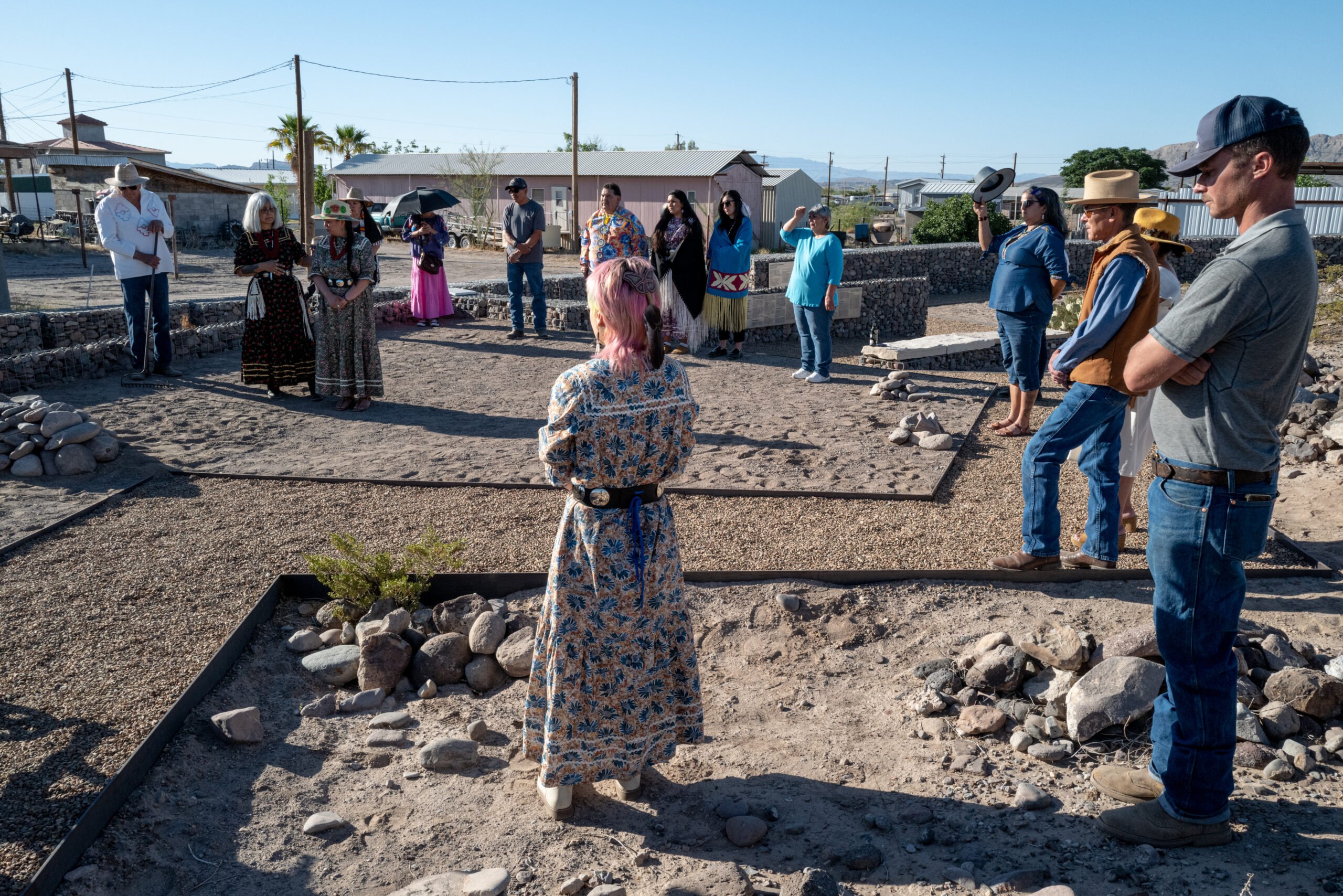
As I finish writing this, I find my words insufficient to fully encapsulate the interconnectedness of people, places, moments, and the history of my family which unfolds—over centuries, perhaps millennia—here, in Texas. To us, it’s kíłááhíí, the land of many houses. We never lost our home, I realize. Unbroken generations of my family are folded within the sun-warmed Earth. We are in the mountains.
I imagine this Elder’s life alongside the arroyo, where water flows in the desert and prickly pears grow in fountains of green paddles and red fruit. She existed centuries before the Lipan Apache formed a cohesive group. But I feel a connection to her. After all, she nourished her family with a metate. Like my great-great-grandmother. Great-grandmother. Grandmother. Mother. Me.
Someday, I will be buried among my people. Will I take my metate with me? Will it stay by my side?
